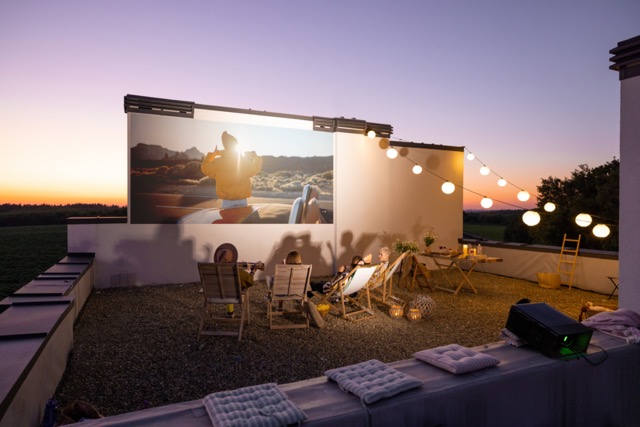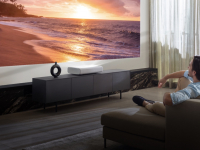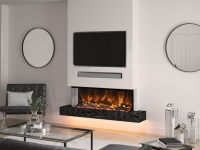Given the typical British summer, many of us like to get our gardens ready to make the most of our time in the sun.
At Richer Sounds, we have an exciting new development to add – outdoor cinema. What could be better than watching your favourite movie on the big screen, in the open air, while enjoying a nice cold drink?
At the heart of any cinema system is the projector. There’s something magical about a projector that a TV can’t quite replicate; it just feels inherently cinematic. Freed from room size constraint, your garden could actually create the ultimate big-screen experience at home.
The Projector
When selecting a projector for outdoors, brighter is nearly always better. Brightness is not, however, the only component of picture quality. Aspects such as colour, motion and sharpness also play a significant role. You can have a bright projector that performs poorly in these other areas. It’s therefore important to consider when and where you are going to use the projector.
If it’s for during the day, it is probably worth concentrating on brightness as a key feature to invest in. If it is primarily for use at night or even in a particularly shady part of the garden, ultimate brightness becomes less important.
As well as vision, there’s also sound to take into account. Some projectors have sound systems built in, with varying levels of power output. You might find the built-in audio system to be adequate but, in most cases, it won’t get close to matching the picture’s cinematic scale. The best option is often a separate audio system – we’ll talk about options for this in Part Two.
Another aspect to think about is Smart features. Some projectors have streaming services such as Netflix built in. Even if you choose a model without this feature, though, our experts can advise on how to integrate it into any outdoor system. Please visit our website to see our full range of projectors.
The Screen
The screen is probably the most misunderstood part of a projection system. It’s easy to assume the projector is the sole contributor to picture quality and that any white surface to project onto will do. The truth is far from this, as the screen often has as much impact on the picture quality as the projector itself.
Unfortunately, the screen doesn’t just reflect the projector’s image but also all of the ambient light it receives, including sunlight. The sun bleaches out darker images so that, in direct light, the image becomes all but unwatchable. We can increase the contrast by selecting a brighter projector, however this doesn’t improve the black levels, it merely makes the bright highlights more visible. Put simply, we need a bright projector and the least amount of ambient light possible at the screen location.
The good news is that there are simple ways to improve contrast. Firstly, make sure that the screen is in the shade as the more shade there is, the better the black levels will be. If you can, position the screen in a part of the garden where trees or garden walls provide shade from the sun. Alternatively, a gazebo or awning can provide a great boost in contrast. Secondly, it sounds obvious, but watching at night greatly improves the contrast, as the sun is no longer an issue.
Selecting the correctly specified screen is critical in getting the best possible contrast. Starting with screen gain, this effectively states the amount of light reflected back from the screen. Any figure above 1.0 shows a light gain. A figure of 1.5, for example, produces 50% more light than from a reference white board. While a high-gain screen can suit outdoors, they do have downsides, including reduced viewing angles. For this reason, we’d recommend checking with our experts for advice on the best screen to suit your specific needs.
The next consideration is using a special type of screen called ALR. ALR or “ambient light rejection” screens selectively reflect light toward an audience, as opposed to regular projector screens, which reflect light in all directions. They reduce or eliminate the negative effects of ambient light, giving you a bright and crisp picture without glare or washout. Read more about ALR screens.
After screen gain and ALR comes the screen’s colour. Darker material tends to enhance black levels at the cost of brightness, whereas lighter materials enhance brightness at the cost of black levels. The perfect balance comes down to your individual requirements and this is something we’re happy to advise on. Please visit our website to see our full range of screens.
Final Thoughts
The final consideration is weather. As we tend to get rather a lot of it, it can have a detrimental effect on your system. Screens are affected by rain, UV light, wind and frost, so positioning is key to a long life. Permanent screens tend to have a slightly lower image quality than removable screens, which may have a bearing on your decision too. Take time in getting the right location and the best screen specs for that particular location and you’re well on your way to brilliant outdoor cinema.
There are times when an outdoor projection system isn’t necessarily the best solution for you though. If you only need a smaller screen and are likely to watch during the daytime, one of the new breed of outdoor, all-weather TVs could make more sense. In recent years, outdoor TV picture quality has vastly improved, making them a top contender for watching the big game in the afternoon. Why not take a look at our range and speak to an expert about this exciting new development in TV.
All this might seem complicated at first, but our colleagues are here to help. If you would like to look into an outdoor cinema, please visit our website or contact us via our Custom Installation form. We’ll put you in touch with the best people to make your garden cinema dreams come true.






